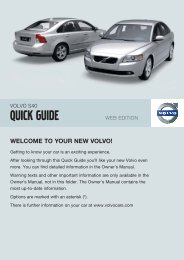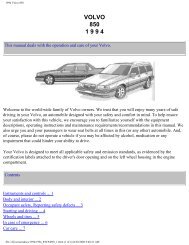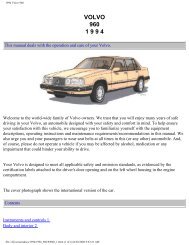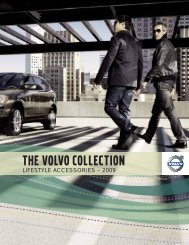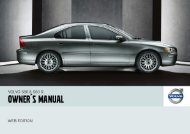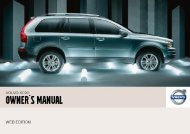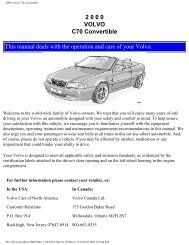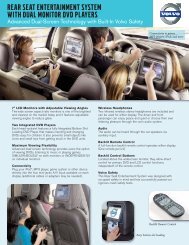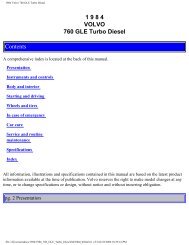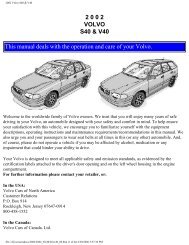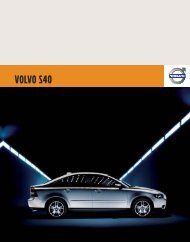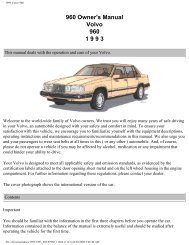V50 w646.book - ESD - Volvo
V50 w646.book - ESD - Volvo
V50 w646.book - ESD - Volvo
You also want an ePaper? Increase the reach of your titles
YUMPU automatically turns print PDFs into web optimized ePapers that Google loves.
06 Starting and driving<br />
General<br />
06<br />
Economical driving<br />
Driving economically means driving smoothly<br />
while thinking ahead and adjusting your driving<br />
style and speed to the prevailing conditions.<br />
• Get the engine warmed up as soon as<br />
possible.<br />
• Do not let the engine idle, but drive at light<br />
loads as soon as it is possible.<br />
• A cold engine consumes more fuel than a<br />
warm one.<br />
• Avoid braking too hard.<br />
• Do not drive with unnecessary loads in the<br />
car.<br />
• Do not use winter tyres when the roads<br />
are dry.<br />
• Remove load carriers when they are not<br />
being used.<br />
• Avoid driving with open windows.<br />
Slippery driving conditions<br />
Practise driving on slippery surfaces under<br />
controlled conditions to learn how the car reacts.<br />
Engine and cooling system<br />
Under special conditions, for example when<br />
driving in hilly terrain, extreme heat or with<br />
heavy loads, there is a risk that the engine<br />
and cooling system will overheat.<br />
Avoid overheating the cooling system<br />
• Maintain a low speed when driving with a<br />
trailer up long, steep ascents.<br />
• Do not turn the engine off immediately you<br />
stop after a hard drive.<br />
• Remove any auxiliary lamps from in front<br />
of the grille if driving in extreme high<br />
temperatures.<br />
Avoid overheating the engine<br />
Do not exceed engine speeds of 4500 rpm<br />
(diesel engine: 3500 rpm) if driving with a<br />
trailer or caravan in hilly terrain. The oil temperature<br />
could then become too high.<br />
Open tailgate<br />
Avoid driving with the tailgate open. If it is<br />
necessary to drive with the tailgate open for a<br />
short distance:<br />
– Close all windows.<br />
– Set the air distribution to the windscreen<br />
and floor and run the fan at high speed.<br />
WARNING<br />
Do not drive with the tailgate open. Toxic<br />
exhaust fumes can be drawn into the car<br />
through the cargo area.<br />
Driving in water<br />
The car can be driven through water at a<br />
maximum depth of 25 cm at a maximum<br />
speed of 10 km/h. Extra caution should be<br />
exercised when passing through flowing water.<br />
IMPORTANT<br />
Engine damage can occur if water enters<br />
the air filter.<br />
In greater depths, water can enter the transmission.<br />
This reduces the lubricating ability<br />
of the oils and shortens the service life of<br />
these systems.<br />
When driving in water, maintain a low speed<br />
and do not stop the car. When the water has<br />
been passed, depress the brake pedal lightly<br />
and check that full brake function is attained.<br />
Water and mud for example can make the<br />
brake linings wet resulting in delayed brake<br />
function.<br />
116



